Study on the Possibility of Rapid Elimination of Accidentally Spilled Petroleum Hydrocarbons in Agricultural Soil
Abstract
1. Introduction
2. Materials and Methods
2.1. Presentation of Experimental Stands
- –
- A plastic box (length 37 cm, width 25 cm, height 15 cm) was chosen in which the following was mounted: a plastic plate with dense and symmetrical holes at 2 cm above the bottom of the box. A layer of gauze (canvas low) was placed to prevent the holes from clogging with solid aggregates of sand and soil. A fine layer of sand, a layer of lightly moistened soil, and then a layer of soil taken directly from the field were placed in the box from bottom to top. Holes were also made at the bottom of the box for the removal of both washing water and pollutants. Holes in the bottom of the vessel were placed in the cathode zone for all experiments, where the hydrocarbons were predominantly directed, but could be placed at any point just for collection, as a rigid plastic plate with holes was placed under the thinnest layer.
- –
- Agricultural soil was chosen for which the physical properties were determined: density, capillarity, granulometry, permeability, pH, nutrient content (NPK), water content, and electrical conductivity. The determination methods are described in the literature [13].
- –
- A pollutant was chosen—diesel oil—for which density and viscosity at various temperatures were determined; these two properties are responsible for the penetration of the pollutant into the soil structure. All physical properties of diesel oil determined in the laboratory (density and viscosity) or that we had available from the source are presented in the paper. In the laboratory, agricultural soil was contaminated with 7% diesel oil, and the sample was placed in a box.
- –
- A 12 V power source (the 5 V version initially used did not give any result).
- –
- Stainless steel and copper electrodes, with geometrical characteristics shown in Table 1 (these materials are available and do not induce new manufacturing costs).
2.2. Statistical Analysis
3. Results
3.1. Soil Characterization
3.2. Characterization of the Pollutant—Diesel Oil
3.3. Determining the Degree of Depollution
3.4. Analyses for Water and NPK Nutrient Content
3.5. Comparative Analyses for Depollution
3.6. Results of Statistical Analysis
4. Discussion
5. Conclusions
Funding
Data Availability Statement
Conflicts of Interest
References
- Popa, M.; Negoita, L.I.; Arnautu, B. Advantages of using the electro-kinetic method for soil depollution. Sci. Pap. Ser. E Land Reclam. Earth Obs. Surv. Environ. Eng. 2019, 8, 192–196. [Google Scholar]
- Streche, C.; Baracu, T.; Apostol, T.; Cocârță, D.M.; Stan, C. Evaluation of the Efficiency of Combining the Electrochemical Remediation and Soil Flushing Methods in the Soil Contamination with Diesel. In Proceedings of the 2017 International Conference on ENERGY and ENVIRONMENT (CIEM), Bucharest, Romania, 19–20 October 2017. [Google Scholar] [CrossRef]
- Li, D.; Ji, G.; Hu, J.; Hu, S.; Yuan, X. Remediation strategy and electrochemistry flushing & reduction technology for real Cr(IV)-contaminated soils. Chem. Eng. J. 2018, 334, 1281–1288. [Google Scholar]
- Lysenko, L.L.; Shen, A.E.; Rynda, E.F. Prevention of Ground water Pollution by Using the Electroosmotic Flushing of Soil systems. J. Water Chem. Technol. 2018, 40, 102–107. [Google Scholar] [CrossRef]
- Han, S.-J.; Kim, S.-S.; Kim, B.-I. Electroosmosis and pore pressure development characteristics in lead contaminated soil during electrokinetic remediation. Geosci. J. 2004, 8, 85–93. [Google Scholar] [CrossRef]
- Ren, L.; Lu, H.; He, L.; Zhang, Y. Enhanced electrokinetic technologies with oxidization-reduction for organically-contaminated soil remediation. Chem. Eng. J. 2014, 247, 111–124. [Google Scholar] [CrossRef]
- Risco, C.; Lopez-Vizcaino, R.; Saez, C.; Yustres, A.; Canizares, P.; Navarro, V.; Rodrigo, M.A. Remediation of soils polluted with 2,4-D by electrokinetic soil flushing with facing rows of electrodes: A case study in a pilot plant. Chem. Eng. J. 2016, 285, 128–136. [Google Scholar] [CrossRef]
- Yuan, C.; Weng, C.H. Remediating ethylbenzene-contaminated clayey soil by a surfactant-aided electrokinetic (SAEK) process. Chemosphere 2004, 57, 225–232. [Google Scholar] [CrossRef] [PubMed]
- Sandu, C.; Popescu, M.; Rosales, E.; Pazos, M.; Lazăr, G.; Sanroman, M.A. Electrokinetic oxidant soil flushing: A solution for in situ remediation of hydrocarbons polluted soils. J. Electroanal. Chem. 2017, 799, 1–8. [Google Scholar] [CrossRef]
- Popescu, M.; Rosales, E.; Sandu, C.; Meijide, J.; Pazos, M.; Lazăr, G.; Sanroman, M.A. Soil flushing and simultaneous degradation of organic pollutants in soils by electrokinetic-Fenton treatment. Process Saf. Environ. Prot. 2017, 108, 99–107. [Google Scholar] [CrossRef]
- Popa, M.; Onuţu, I. Studies on the Seed Germination after Thermal Decontamination of Crude Oil Polluted Soils. Agric. Agric. Sci. Procedia 2016, 10, 452–457. [Google Scholar] [CrossRef]
- Popa, M. The influence of the application of electrical desorption on soil nutrient content. Rom. J. Pet. Gas Technol. 2023, IV, 117–122. [Google Scholar] [CrossRef]
- Popa, M. Remediation of soil contaminated with hydrocarbon used the succesive extraction method with solvents. Ann. Dunarea De Jos Univ. Galati. Fascicle IX Metall. Mater. Sci. 2024, 47, 38–43. [Google Scholar] [CrossRef]
- Micle, V.; Sur, I.M. Experimental Investigation of a Pilot-Scale Concerning Ex-Situ Bioremediation of Petroleum Hydrocarbons Contaminated Soil. Sustainability 2021, 13, 8165. [Google Scholar] [CrossRef]
- Ma, Y.; Cheng, X.; Zhang, Y. The Impact of Humic Acid Fertilizers on Crop Yield and Nitrogen Use Efficiency: A Meta-Analysis. Agronomy 2024, 14, 2763. [Google Scholar] [CrossRef]
- Huang, Q.; Sheng, L.; Wu, T.; Huang, L.; Yan, J.; Li, M.; Chen, Z.; Zhang, H. Research progress on the application of carbon-based composites in capacitive deionization technology. Desalination 2025, 593, 118197. [Google Scholar] [CrossRef]
- Abou-Shady, A.; Osman, M.A.; El-Araby, H.; Khalil, A.K.A.; Kotp, Y.H. Electrokinetics-Based Phosphorus Management in Soils and Sewage Sludge. Sustainability 2024, 16, 10334. [Google Scholar] [CrossRef]
- Lee, J.; Pearce, J.M.; Santoro, D. Electrochemical Method for Nutient Removal in Wastewater: A Review of Advanced Electrode Materials, Process, and Applications. Sustainability 2024, 16, 9764. [Google Scholar] [CrossRef]
- Mulati, H.; Mamat, A.; Ailijiang, N.; Jiang, L.; Li, N.; Hu, Y.; Su, Y. Electrokinetic-Assisted Phytoremediation of Pb-Contaminated Soil: Influences of Periodic Polarity Reversal Direct Current Field. Sustainability 2023, 15, 8439. [Google Scholar] [CrossRef]
- Jeon, E.K.; Jung, J.M.; Kim, W.S.; Ko, S.H.; Baek, K. In situ electrokinetic remediation of As-, Cu-, and Pb- contaminates paddy soil using hexagonal electrode configuration: A full scale study. Environ. Sci. Pollut. Res. 2015, 22, 711–720. [Google Scholar] [CrossRef] [PubMed]
- Jeon, E.K.; Jung, J.M.; Ryn, S.R.; Baek, K. In situ field application of electrokinetic remediation for an As-, Cu-, and Pb- contaminated rice paddy using parallel electrode configuration. Environ. Sci. Pollut. Res. 2015, 22, 15763–15771. [Google Scholar] [CrossRef]
- Shin, S.Y.; Park, S.M.; Baek, K. Electrokinetic Removal of As from Soil Washing Residue. Water Air Soil Pollut. 2016, 227, 223. [Google Scholar] [CrossRef]
- Liu, J.; Cai, H.; Chen, S.; Pi, J.; Zhao, L.A. Review on Soil Nitrogen Sensing Technologies: Challenges, Progress and Perspectives. Agriculture 2023, 13, 743. [Google Scholar] [CrossRef]
- Acosta, M.; Rodríguez-Carretero, I.; Blasco, J.; de Paz, J.M.; Quiñones, A. Non-Destructive Appraisal of Macro- and Micronutrients in Persimmon Leaves Using Vis/NIR Hyperspectral Imaging. Agriculture 2023, 13, 916. [Google Scholar] [CrossRef]
- Abu-Shady, A.; El-Araby, H. Soil electrokinetic remediation to restore mercury-polluted soils: A critical review. Chemosphere 2025, 377, 144336. [Google Scholar] [CrossRef] [PubMed]
- Hamdi, F.M.; Altae, A.; Aedan, Y.; Zhou, J.; Al-Ejji, M.; Hawari, A.H.; Zaidi, S.J.; Mohsen, M.; Kardani, R. Decontamination of Heavy Metals from Soil by Electrokinetic Combined with Reactive Filter Media from Industrial Wastes. Water Air Soil Pollut. 2025, 236, 565. [Google Scholar] [CrossRef]
- Abu-Shady, A.; El-Araby, H. Reverse Polarity-Based Soil Electrokinetic Remediation: A Comprehensive Reviw of the Published Data During the Past 32 Years (1993–2023). ChemEngineering 2024, 8, 82. [Google Scholar] [CrossRef]
- Santos, M.; Rebola, S.; Evtuguin, D.V. Soil Remediation: Current Approaches and Emerging Bio-Based Trends. Soil Syst. 2025, 9, 35. [Google Scholar] [CrossRef]
- Iorga, C.M.; Georgescu, L.P.; Ungureanu, C.; Stancu, M.M. Sustainable Remediation of Polluted Soils from the Oil Industry Using Sludge from Municipal Watewater Treatment Plants. Processes 2025, 13, 245. [Google Scholar] [CrossRef]
- Omo-Okoro, P.; Ofori, P.; Amalapridman, V.; Dadrasnia, A.; Abbey, L.; Emenike, C. Soil Pollution and Its Interrelation with Interfacial Chemistry. Molecules 2025, 30, 2636. [Google Scholar] [CrossRef]
- Wyszkowska, J.; Borowik, A.; Zabrowska, M.; Kucharski, J. Revitalization of Soil Contaminated by Petroleum roducts Using Materials That Improve the Physicochemical and Biochemical Properties of the Soil. Molecules 2024, 29, 5838. [Google Scholar] [CrossRef]
- Jiang, D.; Li, T.; Liang, X.; Zhao, X.; Li, S.; Li, Y.; Oh, K.; Liu, H.; Cao, T. Evaluation of Petroleum Hydrocarbon-Contaminated Soil Remediation Technologies and Their Effects on Soybean Growth. Environments 2025, 12, 6. [Google Scholar] [CrossRef]
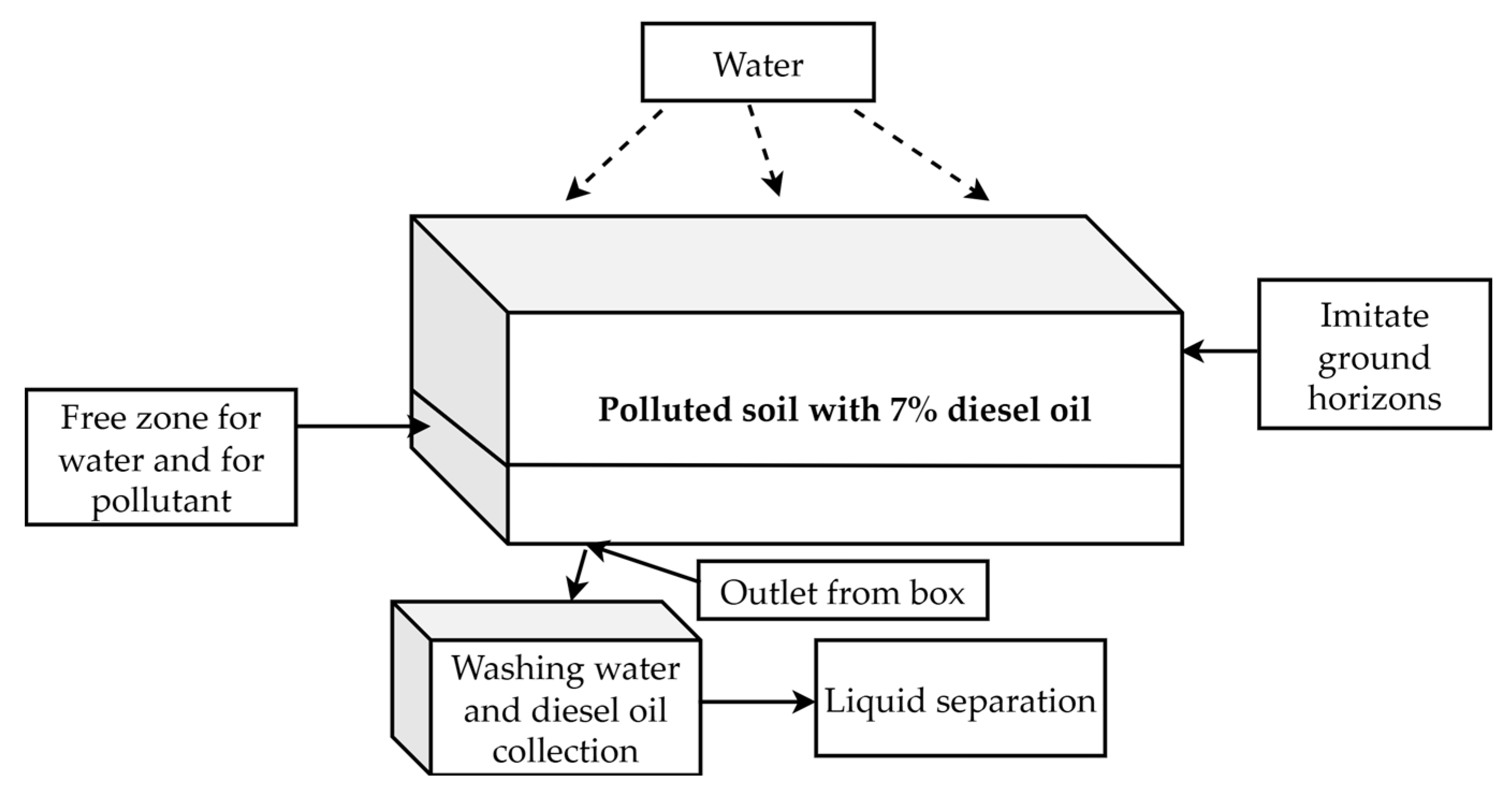
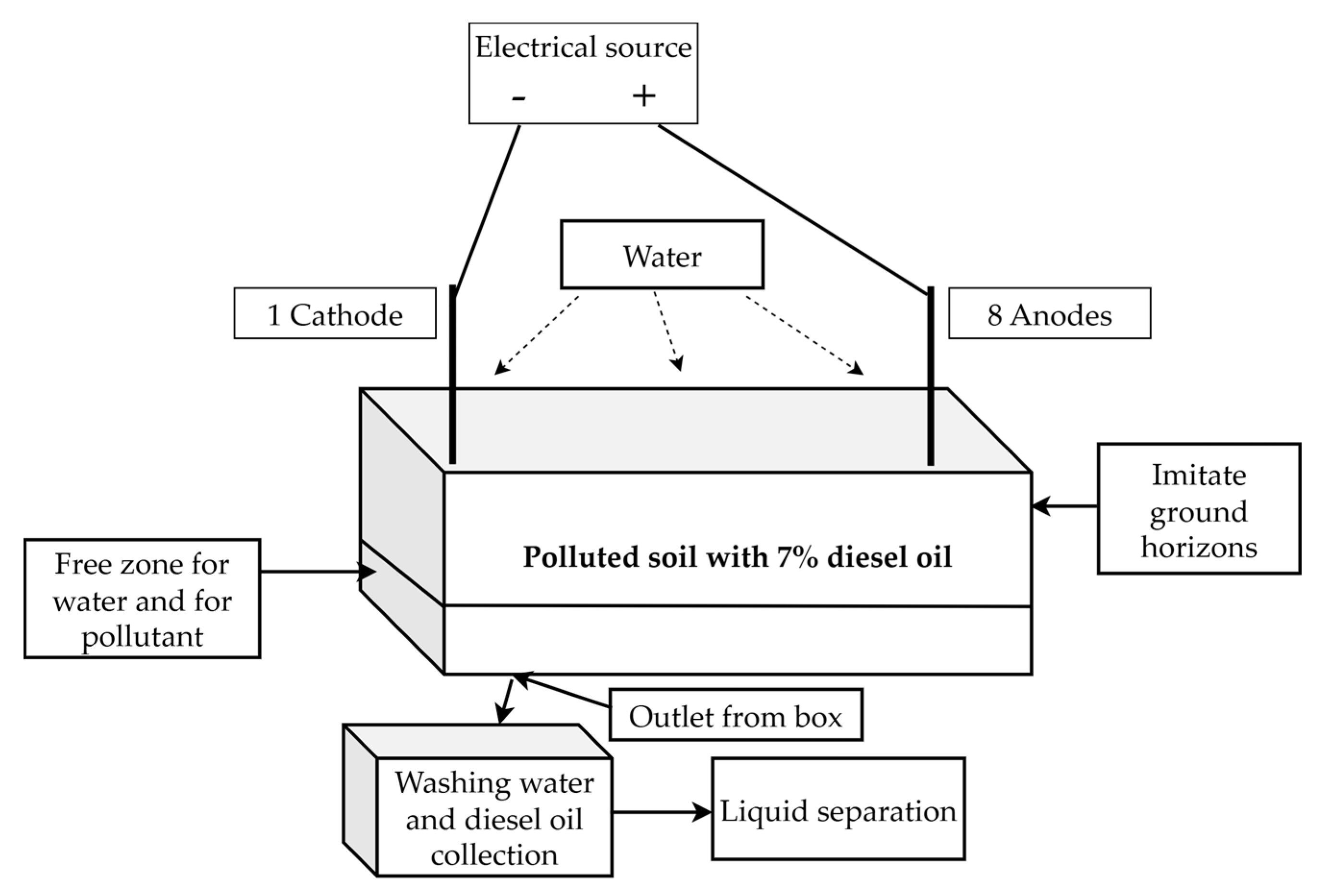
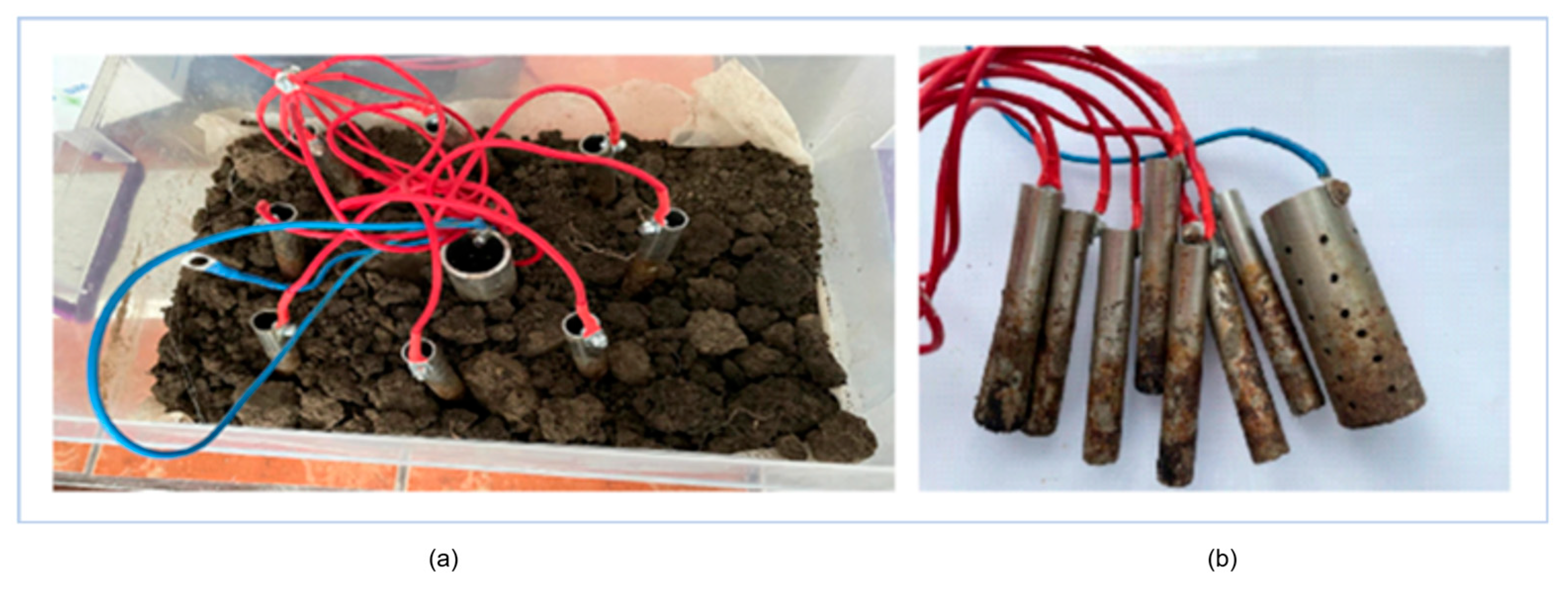
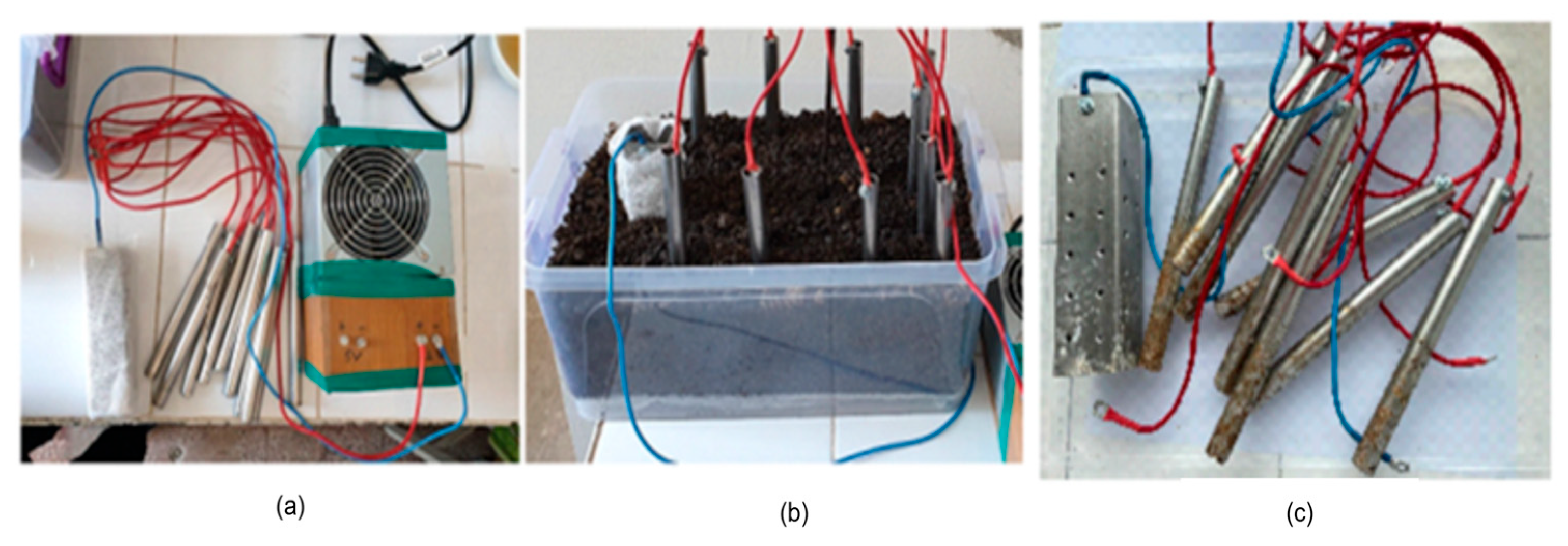
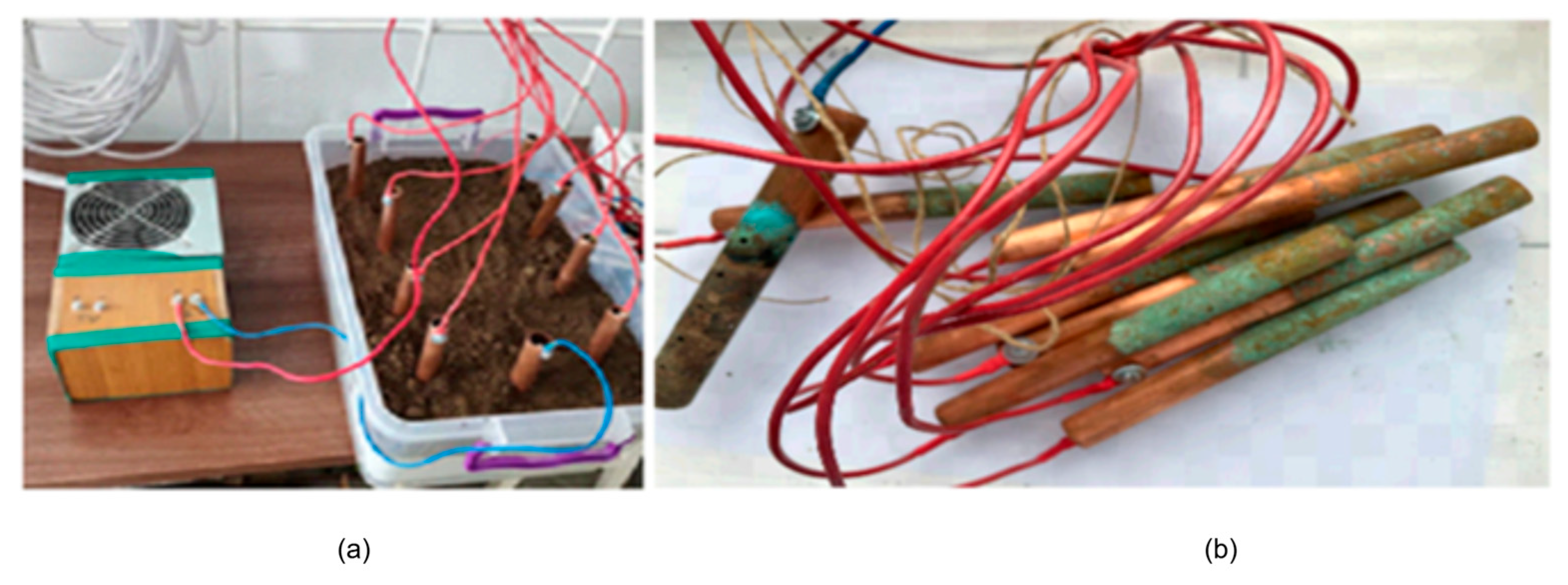
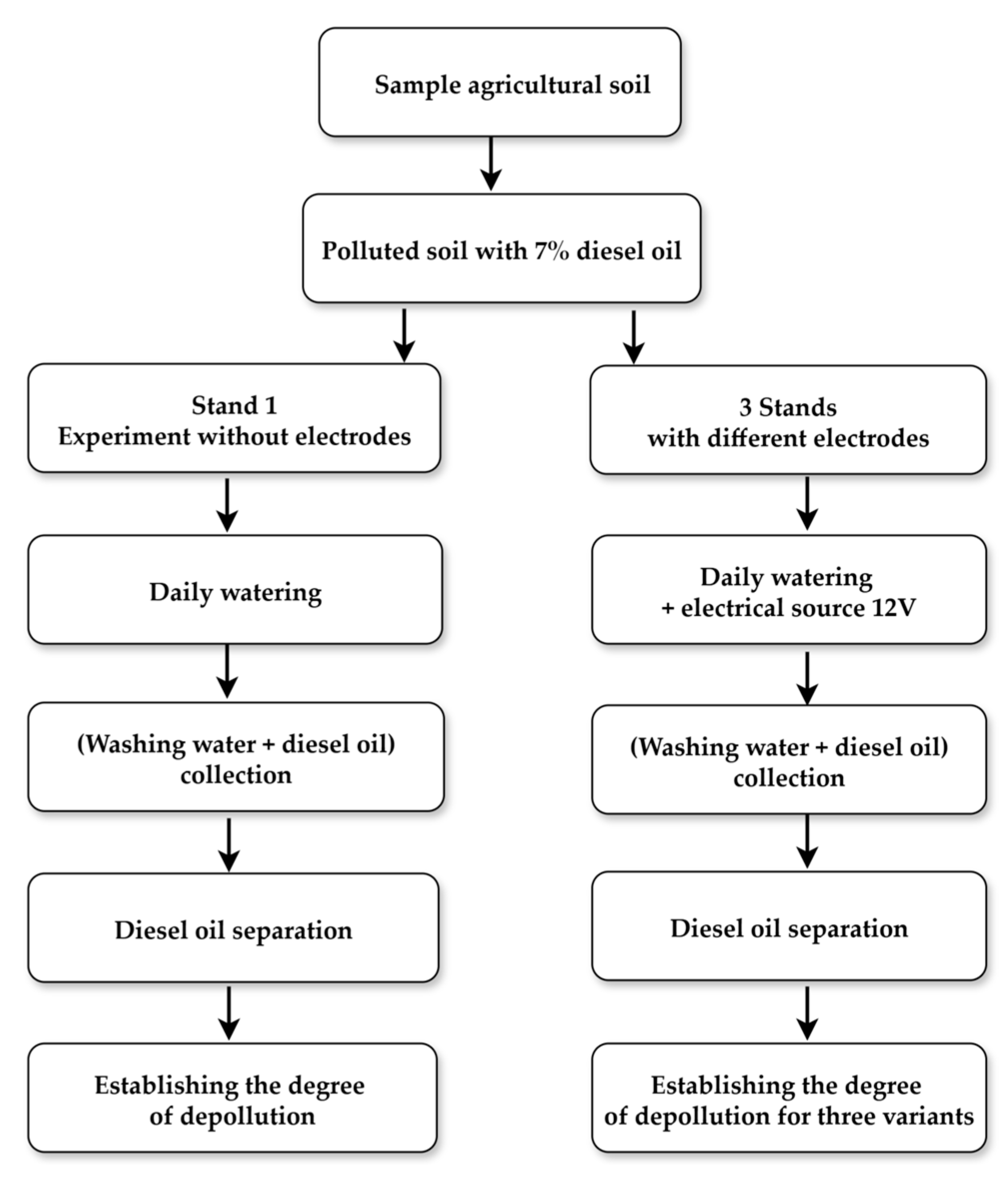
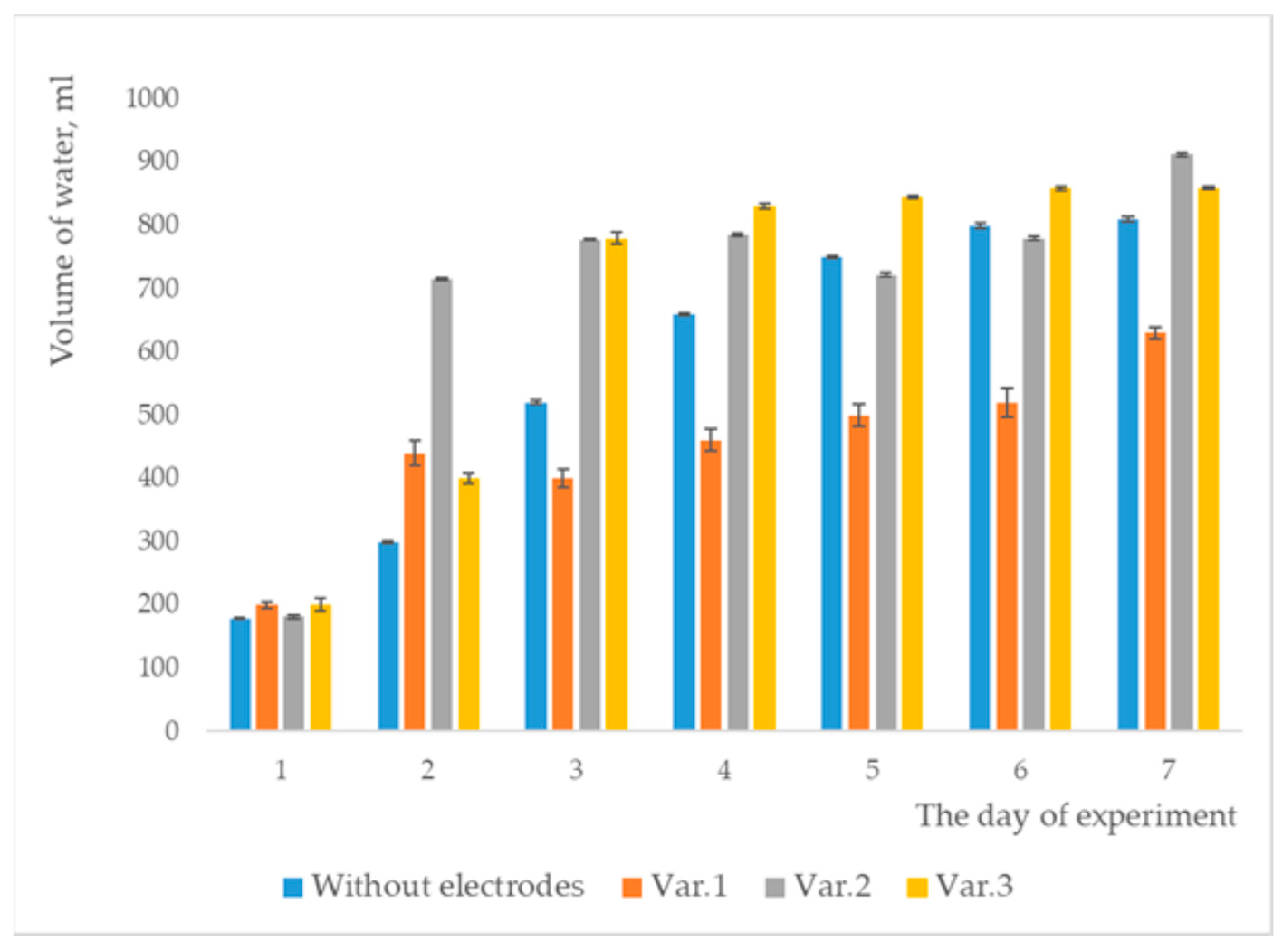
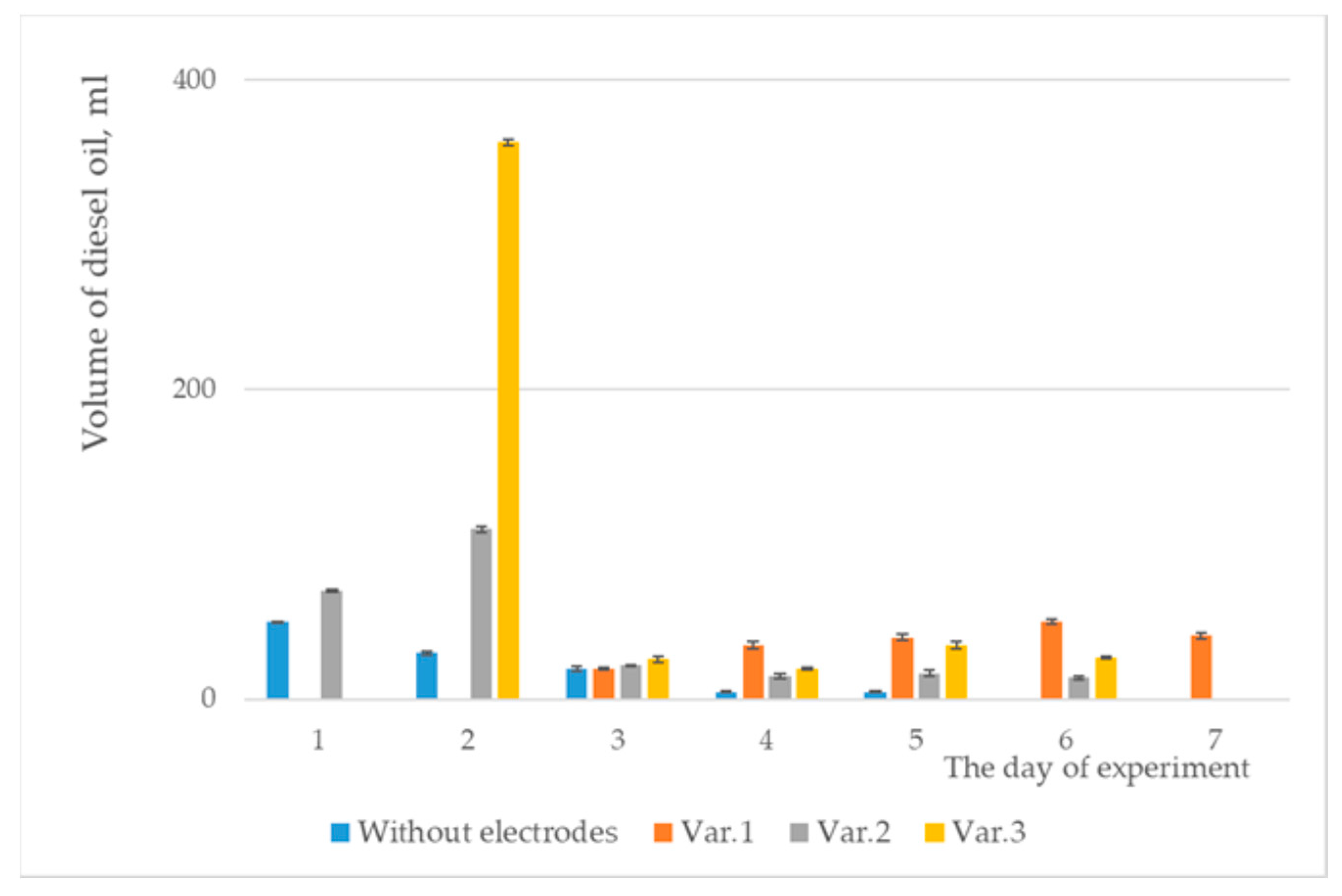
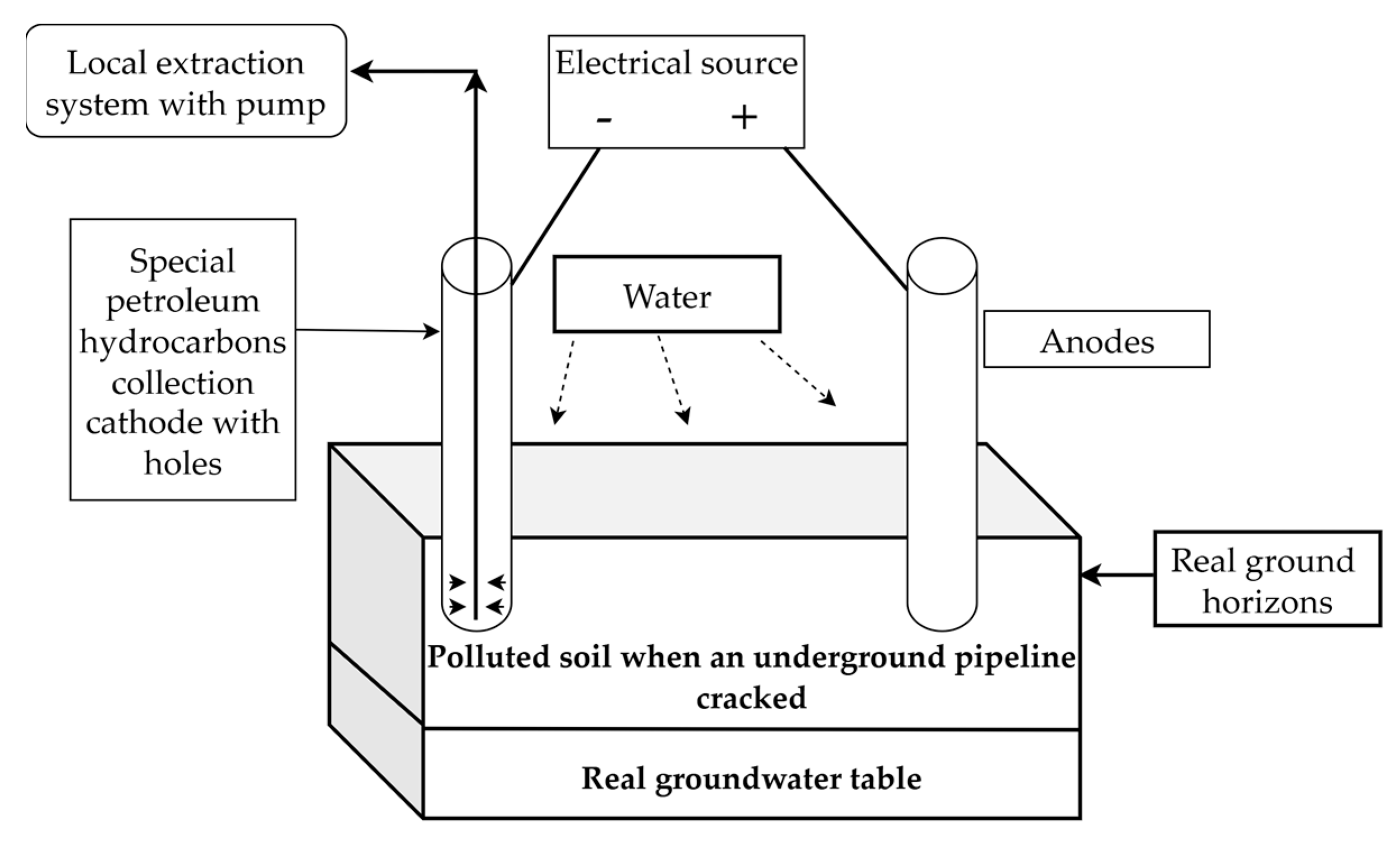
| Type of Electrodes | No. Variant | Material | Length, mm | Inner Diameter, mm | External Diameter, mm |
|---|---|---|---|---|---|
| Cylindrical anode | 1 | Stainless steel | 150 | 13 | 15 |
| Cylindrical cathode | 28 | 33 | |||
| Cylindrical anode | 2 | Stainless steel | 150 | 13 | 15 |
| Rectangular cathode | l = 40 mm δ = 2 mm | ||||
| Cylindrical anode | 3 | Copper | 150 | 13 | 15 |
| Cylindrical cathode | 16 | 18 | |||
| No.crt. | Properties | Value | UM |
|---|---|---|---|
| 1. | Apparent density | 0.8217 | g/cm3 |
| 2. | Real density | 1.668 | |
| 3. | Porosity | 0.5073 | |
| 4. | Capillarity—to water—maximum wetted layer height Capillarity—to pollutant—maximum wetted layer height | 63 95 | mm |
| 5. | Permeability—to water Permeability—to pollutant | 1063 100 | cm3/h |
| 6. | Retention capacity— to water Retention capacity—to pollutant | 487 338 | kg/m3 |
| 7. | Granulometry (site holes diameters) -di = 1.6 mm -di = 1.0 mm -di = 0.5 mm -di = 0.25 mm | 44.6 21.2 19 15.2 | % |
| 8. | pH | 6–7 | |
| 9. | Water content | 15 | % |
| 10. | Nutrient content N high P low K high | 30–50 5–15 30–50 | ppm |
| 11. | Electrical conductivity in soil solution | 0.8 | mS/cm |
| Temp., °C | ρ, kg/m3 | Engler Conventional Viscosity, °E | Dynamic Viscosity, μ, kg/ms |
|---|---|---|---|
| 20 | 837.2 | 1.430 | 5.06 × 10−6 |
| 40 | 820.1 | 1.305 | 3.86 × 10−6 |
| 60 | 814.3 | 1.213 | 2.98 × 10−6 |
| No.crt. | Properties | Value | UM |
|---|---|---|---|
| 1. | Flash point | 58.5 | °C |
| 2. | Corrosion on copper blade | Class 1 | - |
| 3. | Sulfur content | 5.5 | ppm |
| 4. | Lubricating power: corrected wear spot diameter (WSD) | 430 | µm |
| 5. | Cetane number | 51 | - |
| 6. | Cetane index | 46 | - |
| 7. | Distillation data Initial 50% 95% 100% | 164.3 262.6 357.7 365 | °C |
| The Experiment Day | The Water Introduced mL | Collected Samples | |
|---|---|---|---|
| Water mL (M ± SD) | Diesel Oil mL (M ± SD) | ||
| Day 1 | 1000 | 178 ± 1 | 50 ± 0.577 |
| Day 2 | 1000 | 300 ± 2 | 30 ± 1.154 |
| Day 3 | 1000 | 520 ± 3.214 | 20 ± 1.527 |
| Day 4 | 1000 | 660 ± 1.527 | 5 ± 0.577 |
| Day 5 | 1000 | 750 ± 2.516 | 5 ± 0.577 |
| Day 6 | 1000 | 800 ± 3.605 | − |
| Day 7 | 1000 | 810 ± 3.464 | − |
| Total collected | 4018 | 110 | |
| Degree of depollution achieved without electrodes, % = 12.44 | |||
| The Experiment Day | Water mL | Collected Samples Var. 1. | Collected Samples Var. 2. | Collected Samples Var. 3. | |||
|---|---|---|---|---|---|---|---|
| Water mL (M ± SD) | Diesel Oil mL (M ± SD) | Water mL (M ± SD) | Diesel Oil mL (M ± SD) | Water mL (M ± SD) | Diesel Oil mL (M ± SD) | ||
| Day 1 | 1000 | 200 ± 6 | − | 181 ± 2.645 | 70 ± 1 | 200 ± 10 | − |
| Day 2 | 1000 | 440 ± 20 | − | 715 ± 2.645 | 110 ± 2 | 400 ± 8.660 | 360 ± 2 |
| Day 3 | 1000 | 400 ± 15 | 20 ± 1 | 778 ± 1.732 | 22 ± 0.577 | 780 ± 8.660 | 26 ± 2.081 |
| Day 4 | 1000 | 460 ± 17.4356 | 35 ± 2 | 785 ± 2 | 15 ± 1.732 | 830 ± 4.358 | 20 ± 1 |
| Day 5 | 1000 | 500 ± 17.3205 | 40 ± 2 | 722 ± 2.645 | 17 ± 1.732 | 845 ± 1.527 | 35 ± 2.645 |
| Day 6 | 1000 | 520 ± 22.912 | 50 ± 1.732 | 780 ± 2 | 14 ± 1 | 859 ± 3.055 | 27 ± 1 |
| Day 7 | 1000 | 630 ± 10 | 41 ± 1.732 | 912 ± 3 | − | 860 ± 2 | − |
| Total collected, mL | 3150 | 186 | 4873 | 248 | 4774 | 468 | |
| Degree of depollution achieved, % | 21.04 | 28.05 | 52.94 | ||||
| Properties for Water | Potable Water | Without Electrodes (M ± SD) | Var. 1 (M ± SD) | Var. 2 (M ± SD) | Var. 3 (M ± SD) |
|---|---|---|---|---|---|
| pH | 7.15 | 10.17 ± 0.07 | 11.72 ± 0.03 | 11.8 ± 0.360 | 11 ± 0.00 |
| Electrical conductivity, µS/cm | 1120 | 608 ± 3.605 | 449 ± 1.732 | 495 ± 4.358 | 393 ± 1 |
| Salinity, mg/L | 550 | 294 ± 3.605 | 236 ± 4 | 238 ± 2.645 | 205 ± 3 |
| Nutrients | Variant 1 | Variant 2 | Variant 3 |
|---|---|---|---|
| N | High 30–50 ppm | High 30–50 ppm | Low 5–15 ppm |
| P | Low 5–15 ppm | Low 5–15 ppm | 30–50 ppm Medium |
| K | High 30–50 ppm | High 30–50 ppm | Medium 15–30 ppm |
| Method of Depollution | Degree of Depollution % | References |
|---|---|---|
| Extraction with solvents | 73 | [13] |
| Combustion | 100 | [1] |
| Desorption with electric heating | 93 | [12] |
| Desorption with gaseous fuel combustion | 80 | [1] |
| Electrokinetic depollution with copper electrodes—new proposal | 52.94 | |
| Method of Depollution | Costs |
|---|---|
| Extraction | 100 USD/m3 |
| Soil washing | 500 USD/m3 |
| Thermal method | 600 USD/t |
| Electrokinetic | 275 USD/m3 |
| The Experiment Day | The Experimental Stands | ||||
|---|---|---|---|---|---|
| Without Electrodes | Var. 1 | Var. 2 | Var. 3 | ||
| Day 1 | Value/ replicate | 178 179 177 | 205 195 200 | 184 180 179 | 200 210 190 |
| M | 178 | 200 | 181 | 200 | |
| SD | 1 | 5 | 2.645 | 10 | |
| CV, % | 0.561 | 2.5 | 1.461 | 5 | |
| SEM | 0.577 | 2.89 | 1.527 | 5.77 | |
| p-value | 2.03 × 10−3 | ||||
| Day 2 | Value/ replicate | 302 300 298 | 420 440 460 | 716 717 712 | 405 390 405 |
| M | 300 | 440 | 715 | 400 | |
| SD | 2 | 20 | 2.645 | 8.660 | |
| CV, % | 0.666 | 4.545 | 0.370 | 2.165 | |
| SEM | 1.154 | 11.545 | 1.527 | 5 | |
| p-value | 3.34 × 10−10 | ||||
| Day 3 | Value/ replicate | 524 519 518 | 385 400 415 | 776 779 779 | 770 785 785 |
| M | 520 | 400 | 778 | 780 | |
| SD | 3.214 | 15 | 1.732 | 8.660 | |
| CV, % | 0.617 | 3.750 | 0.222 | 1.110 | |
| SEM | 1.855 | 8.660 | 1 | 5 | |
| p-value | 3.304 × 10−11 | ||||
| Day 4 | Value/ replicate | 658 660 661 | 472 440 468 | 783 787 785 | 828 827 835 |
| M | 660 | 460 | 785 | 830 | |
| SD | 1.527 | 17.435 | 2 | 4.358 | |
| CV, % | 0.231 | 3.790 | 0.254 | 0.525 | |
| SEM | 0.881 | 10.066 | 1.154 | 2.516 | |
| p-value | 1.232 × 10−10 | ||||
| Day 5 | Value/ replicate | 747 752 750 | 490 520 490 | 725 721 720 | 847 844 845 |
| M | 750 | 500 | 722 | 845 | |
| SD | 2.516 | 17.320 | 2.645 | 1.527 | |
| CV, % | 0.335 | 3.464 | 0.366 | 0.180 | |
| SEM | 1.452 | 10 | 1.527 | 0.881 | |
| p-value | 2.835 × 10−10 | ||||
| Day 6 | Value/ replicate | 805 800 798 | 525 540 495 | 782 780 778 | 862 860 856 |
| M | 800 | 520 | 780 | 859 | |
| SD | 3.605 | 22.912 | 2 | 3.055 | |
| CV, % | 0.450 | 4.406 | 0.256 | 0.355 | |
| SEM | 2.081 | 13.228 | 1.154 | 1.763 | |
| p-value | 2.056 × 10−9 | ||||
| Day 7 | Value/ replicate | 808 814 808 | 620 640 630 | 915 912 909 | 862 858 860 |
| M | 810 | 630 | 912 | 860 | |
| SD | 3.464 | 10 | 3 | 2 | |
| CV, % | 0.427 | 1.587 | 0.328 | 0.232 | |
| SEM | 2 | 5.773 | 1.732 | 1.154 | |
| p-value | 2.843 × 10−11 | ||||
| The Experiment Day | The Experimental Stands | ||||
|---|---|---|---|---|---|
| Without Electrodes | Var. 1 | Var. 2 | Var. 3 | ||
| Day 1 | Value/ replicate | 49 50 50 | 0 0 0 | 69 70 71 | 0 0 0 |
| M | 50 | 0 | 70 | 0 | |
| SD | 0.577 | 0 | 1 | 0 | |
| CV, % | 1.162 | 0 | 1.428 | 0 | |
| SEM | 3.33 × 10−1 | 0 | 5.77 × 10−1 | 0 | |
| p-value | 7.45 × 10−15 | ||||
| Day 2 | Value/ replicate | 30 30 32 | 0 0 0 | 112 110 108 | 358 360 362 |
| M | 30 | 0 | 110 | 360 | |
| SD | 1.154 | 0 | 2 | 2 | |
| CV, % | 3.765 | 0 | 1.818 | 0.555 | |
| SEM | 0.666 | 0 | 1.154 | 1.154 | |
| p-value | 9.014 × 10−17 | ||||
| Day 3 | Value/ replicate | 22 20 19 | 20 19 21 | 22 22 21 | 25 24 28 |
| M | 20 | 20 | 22 | 26 | |
| SD | 1.527 | 1 | 0.577 | 2.081 | |
| CV, % | 7.512 | 5 | 2.664 | 8.110 | |
| SEM | 0.881 | 0.577 | 0.333 | 1.201 | |
| p-value | 0.0042 | ||||
| Day 4 | Value/ replicate | 5 4 5 | 33 35 37 | 14 14 17 | 20 21 19 |
| M | 5 | 35 | 15 | 20 | |
| SD | 0.577 | 2 | 1.732 | 1 | |
| CV, % | 12.371 | 5.714 | 11.547 | 5 | |
| SEM | 0.333 | 1.154 | 1 | 0.577 | |
| p-value | 4.267 × 10−8 | ||||
| Day 5 | Value/ replicate | 5 6 5 | 40 42 38 | 18 18 15 | 37 32 36 |
| M | 5 | 40 | 17 | 35 | |
| SD | 0.577 | 2 | 1.732 | 2.645 | |
| CV, % | 10.825 | 5 | 10.18 | 7.559 | |
| SEM | 0.33 | 1.154 | 1 | 1.527 | |
| p-value | 5.416 × 10−8 | ||||
| Day 6 | Value/ replicate | 0 0 0 | 48 51 51 | 15 14 13 | 28 26 27 |
| M | 0 | 50 | 14 | 27 | |
| SD | 0 | 1.732 | 1 | 1 | |
| CV, % | 0 | 3.464 | 7.142 | 3.703 | |
| SEM | 0 | 1 | 0.577 | 0.577 | |
| p-value | 8.922 × 10−11 | ||||
| Day 7 | Value/ replicate | 0 0 0 | 40 40 43 | 0 0 0 | 0 0 0 |
| M | 0 | 41 | 0 | 0 | |
| SD | 0 | 1.732 | 0 | 0 | |
| CV, % | 0 | 4.224 | 0 | 0 | |
| SEM | 0 | 1 | 0 | 0 | |
| p-value | 1.547 × 10−11 | ||||
| The Experiment Day | The Experimental Stands | ||||
|---|---|---|---|---|---|
| Without Electrodes | Var. 1 | Var. 2 | Var. 3 | ||
| pH | Value/ replicate | 10.25 10 10.14 | 11.75 11.69 11.72 | 11.5 11.7 12.2 | 11 11 11 |
| M | 10.17 | 11.72 | 11.8 | 11 | |
| SD | 0.07 | 0.03 | 0.360 | 0 | |
| CV, % | 0.688 | 0.255 | 3.055 | 0 | |
| SEM | 0.04 | 0.017 | 0.208 | 0 | |
| p-value | 1.480 × 10−5 | ||||
| Electrical conductivity, µS/cm | Value/ replicate | 612 607 605 | 450 447 450 | 500 492 493 | 393 394 392 |
| M | 608 | 449 | 495 | 393 | |
| SD | 3.605 | 1.732 | 4.358 | 1 | |
| CV, % | 0.593 | 0.385 | 0.880 | 0.254 | |
| SEM | 2.081 | 1 | 2.516 | 0.577 | |
| p-value | 2.087 × 10−12 | ||||
| Salinity, mg/L | Value/ replicate | 298 293 291 | 240 232 236 | 240 235 239 | 208 205 202 |
| M | 294 | 236 | 238 | 205 | |
| SD | 3.605 | 4 | 2.645 | 3 | |
| CV, % | 1.226 | 1.694 | 1.111 | 1.463 | |
| SEM | 2.08 | 2.309 | 1.527 | 1.732 | |
| p-value | 6.708 × 10−9 | ||||
Disclaimer/Publisher’s Note: The statements, opinions and data contained in all publications are solely those of the individual author(s) and contributor(s) and not of MDPI and/or the editor(s). MDPI and/or the editor(s) disclaim responsibility for any injury to people or property resulting from any ideas, methods, instructions or products referred to in the content. |
© 2025 by the author. Licensee MDPI, Basel, Switzerland. This article is an open access article distributed under the terms and conditions of the Creative Commons Attribution (CC BY) license (https://creativecommons.org/licenses/by/4.0/).
Share and Cite
Popa, M. Study on the Possibility of Rapid Elimination of Accidentally Spilled Petroleum Hydrocarbons in Agricultural Soil. Agriculture 2025, 15, 1734. https://doi.org/10.3390/agriculture15161734
Popa M. Study on the Possibility of Rapid Elimination of Accidentally Spilled Petroleum Hydrocarbons in Agricultural Soil. Agriculture. 2025; 15(16):1734. https://doi.org/10.3390/agriculture15161734
Chicago/Turabian StylePopa, Maria. 2025. "Study on the Possibility of Rapid Elimination of Accidentally Spilled Petroleum Hydrocarbons in Agricultural Soil" Agriculture 15, no. 16: 1734. https://doi.org/10.3390/agriculture15161734
APA StylePopa, M. (2025). Study on the Possibility of Rapid Elimination of Accidentally Spilled Petroleum Hydrocarbons in Agricultural Soil. Agriculture, 15(16), 1734. https://doi.org/10.3390/agriculture15161734






